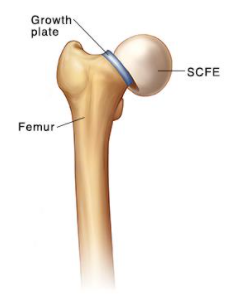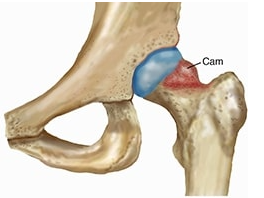Slipped Capital Femoral Epiphysis: The Underlying Mechanism for FAI?
Slipped capital femoral epiphysis, or SCFE for short, is a growing concern. This is a condition that affects adolescents and can range from mild to severe. The hip is a ball and socket joint, with the ball being the top of the femur. Just below the ball is a growth plate, and with increased shear forces on this growth plate, the ball can slip backward and down. This is what is known as SCFE.
Why does this happen? Growing rates of childhood obesity are the most cited reason. It can also occur due to trauma, hormonal changes, or from chronic inflammation. It affects boys more than girls. Patients will typically present with decreased range of motion in flexion, abduction, and internal rotation. They will also usually limp and complain of pain that radiates into the knee. This is important to identify because if it is unstable and not surgically addressed, it can lead to necrosis of the bone.
There are various studies that show that as obesity rates increase, so does the rate of SCFE. For the more severe cases, the patient is surgically repaired. For more stable and less symptomatic SCFE, the patient is given crutches to allow for healing. The problem is, because the symptoms can radiate to the knee, the patient is often misdiagnosed and the SCFE progresses leading to permanent damage and bony changes. Additionally, many cases are likely not brought to attention because obese children are less active so symptoms are not elicited.
Femoral Acetabular Impingement has also garnered a lot of attention in the past decade and surgical cases are on the rise. When you look at the cam deformity, it looks a lot like an older version of SCFE.
Both feature a bony protrusion on the neck of the femur. Clinically, they present the same; pain in the front of the hip with hip flexion and/or internal rotation. In 2017, Jones et. al found that increasing severity of slip deformity was a predictor of impingement and hip flexion loss, with concurrent damage to the anterosuperior aspect of the acetabulum.
It is important for clinicians that see adolescent patients to recognize this pattern to catch it before it progresses. I believe that is also incumbent upon physical therapists to have a conversation with patients and family members about dietary choices as obesity and chronic inflammation both stress the growth plate, and can be mitigated with avoidance of obesogenic and inflammatory foods.
Reference:
Jones, C. E., Cooper, A. P., Doucette, J., Buchan, L. L., Wilson, D. R., Mulpuri, K., & D’Entremont, A. G. (2017). Relationships between severity of deformity and impingement in slipped capital femoral epiphysis. Journal of Pediatric Orthopaedics, 37(4), 272-278. doi:10.1097/bpo.0000000000000641



